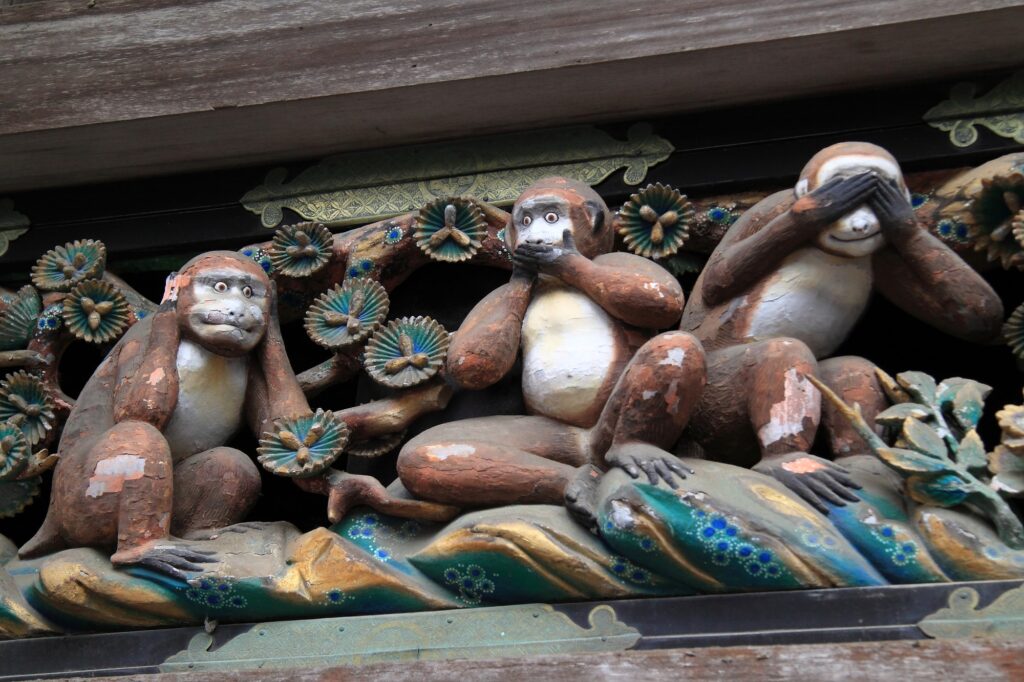[ad_1]
A well-known historic Japanese saying about evil is Mizaru, Iwazaru, Kikazaru: See not, Speak not, Hear not. This maxim puns the archaic conjugation for “do not” (-zaru) on “monkey” (saru).
Over the centuries, visual depictions of this maxim as embodied in three monkeys have become a fixture in Japanese art. Even Nikkō Tōshō-gū, the grand mausoleum-shrine of shogun Tokugawa Ieyasu, bears a carving attributed to Hidari Jingorō of the three monkeys, one covering its eyes, one its mouth, and one its ears.
Against that background, in an irony so brazen it boggles the mind, on 6 October, the Tokyo Metropolitan Police Department reported the arrest of a Japanese man who attempted to smuggle not three, but 21– yes, you read that correctly– monkeys into the country on his return from Thailand. Read on for what we know so far.
A Failed Smuggling

On 3 June, Machino Yoshihiko, 48, arrived at Tokyo’s Haneda Airport on a flight from Suvarnabhumi Airport in Thailand. Hidden not so inconspicuously in his luggage were 21 monkeys.
Yes, you read that number correctly: twenty-one (21) monkeys.
Machino was a part-time employee at a pet shop in Kawaguchi, a city in Saitama Prefecture just north of Tokyo. He hid these monkeys in metal vessels within cardboard boxes and a suitcase. Customs officials were only alerted about what he was trying to do after the man’s arrival at Haneda when there was screeching from within one of the vessels.
Mainichi Shinbun detailed Machino’s smuggling arrangement for the monkeys as follows:
The monkeys were reportedly separated into groups and placed inside pouches, which were then packed inside metal bowl-like containers that were fit together to form spheres, and placed inside cardboard boxes and a suitcase with clothing, snacks and other items.
A customs official removed one of the spheres for inspection and felt a suspicious warmth inside. Machino’s initial response was to caution the official that the vessels were breakable. Only after one of the monkeys screeched, did Machino admit, “there are monkeys inside.”
Police displayed these bowls, the suitcase, and the rest of the paraphernalia with which Machino attempted to smuggle the animals in photos distributed to the Japanese press.
Machino attempted to smuggle four species of monkey. Twelve were Senegal Bushbabies, three were golden-handed tamarins, three were endangered western pygmy marmosets, and a further three were common squirrel monkeys. One of the tamarins was already dead when the customs officials inspected Machino’s luggage.
Popularity Despite a Ban
It isn’t as though there aren’t indigenous species of monkeys in Japan. The Japanese snow monkey (nihonzaru) is a familiar sight around some hot springs in Japan. Indeed, this species is the one that appears in the famous representations of the Three Monkeys mentioned at the top of this article. Others include this woodblock print of 16th-century warlord Katō Kiyomasa with his own pet snow monkey.

Despite this, exotic monkeys have grown increasingly popular in Japan as pets, despite their illegality. Beginning on July 1st 2005, the Japanese government banned the importation of monkeys. The intent was to prevent the spread of diseases like ebola for which monkeys are a known vector.
Monkey aficionados in Japan have consequently had no choice but to interbreed monkeys already imported to Japan. Even so, over time, their numbers have continued to decline. This has simultaneously led to pet monkeys becoming ever-increasingly expensive, And some are increasingly popular on social media because of their rarity, both of which are perhaps unsurprising catalysts for attempts at smuggling.
Part of a Profitable Pattern
Machino is not the only person to attempt to smuggle monkeys into Japan. Over the past decade alone there have been several other incidents. A pet store in Nagoya even reported a transaction involving an illegally imported monkey valued at ¥2,000,000, or about $14,000.
Unfortunately, upon customs officials’ discovery of the monkeys in Machino’s luggage, one had already died. Nine more died of exhaustion during quarantine. An unnamed Japanese zoo is now housing the surviving 11, which have been examined and found to be free of viruses.
Far from denying what he’s done, Machino has admitted responsibility, saying that he planned to raise them personally.
Machino was reported to have purchased each monkey for approximately ¥40,000-¥50,000 ($280-$350) in Thailand. In light of the fact that one estimate prices them in Japan as ¥600,000 to ¥1.8 million ($4100-$12,000 dollars), Machino’s defense of his motivations rings rightly hollow.
Sources
[ad_2]
Source link



